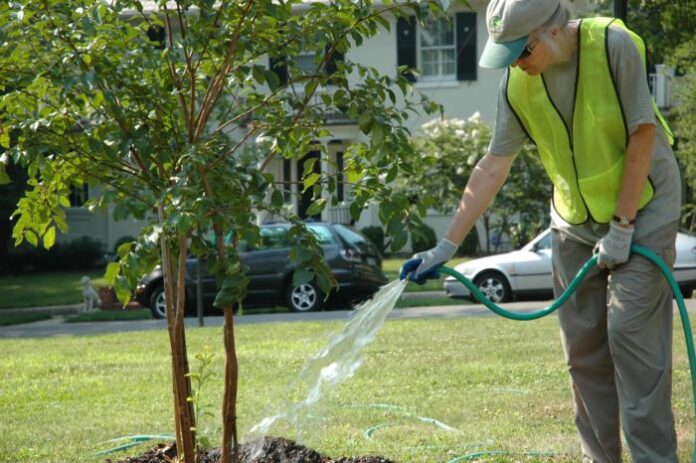Trees make a fantastic addition to your landscape. They’re strong, beautiful and add a lot of character to your home. Whether there were trees in your yard before you moved in or you’ve planted them yourself, it’s important to remember that they need care and maintenance, just like plants do.
According to integritytreepros.com, while you might not think a tree needs watering, different examples and different circumstances will mean that a tree needs water to be able to thrive and stay healthy.
Find out all of the information you need about watering.
When it needs watering

If the weather has been particularly dry lately, it’s a safe bet that your tree will need watering. While rainwater is usually enough to keep the ground moist enough to feed, in the summer months especially, rain can be lacking. Extended periods of drought can wreak havoc on your yard, meaning that your trees lack the water they need to stay hydrated and healthy.
Different kinds will require different levels of watering. It will all depend on the age, size, and type. The best way to work it out is to check the surrounding soil. If the surrounding soil is moist, then this should be sufficient. If the weather is so dry that the surface of your soil is particularly dry, you should use a garden tool to check deeper into the soil. If this appears dry, then it’s safe to say that your tree will need watering.
How much water should you give your tree?

There’s a good rule of thumb that says you should give 10 gallons of water per inch of the diameter of the tree, added Garden Tool Shed.
But knowing how much to water is only part of it. You also need to know the best techniques to make sure you water properly to ensure it gets the most out of the water. It would be best if you tried to aim deep when watering, which is why drip lines are commonly used.
It would be best if you also were careful with the time of day you water your tree, the same with the other plants and shrubs that grow in your garden. Try to water when the sun isn’t out – early morning or late evening is best. This will stop the water evaporating due to heat from the sun.
Making sure you stay consistent with care

Care requires consistency to get it right. You should make sure the soil surrounding your tree is moist at all times, instead of waiting for your soil to dry out before you water it. If you leave the soil to dry out, you could distress, leaving it vulnerable to different diseases and other issues that can affect a tree’s health.
Different watering tools can help you get the right supply to your tree, including a regular hose, soaker hose, drip lines, and sprinklers. Make sure there is an even supply distributed all around the tree to ensure the best impact.
Watering newly planted

Newly planted trees require different care than older. As they are still growing and are in a fresh stage, they will need a lot of water to help them grow stronger. In those first few months after planting, it’s likely the roots will stay contained in the root ball. You’ll need to concentrate your watering efforts on this area, gradually expanding outwards as the roots grow. It can take around two years for a tree to become established.
If the weather is hot and dry, make sure you feed your newly planted several times a week to ensure effective care.
Choosing the right example

If you’ve not thought much about maintenance before, it’s important to do your research before selecting for your backyard. Choosing one that require little watering and maintenance can suit a busy household, allowing you to feed them through rainwater mainly. However, a more exotic tree might need additional watering, as well as plenty of sunlight to help keep it healthy.
Look for trees that are drought-tolerant such as birch and Judas trees. For example, oak can survive a moderate drought, but if things get severe, you’ll need to water it. If you live in an area that is prone to water conservation measures during hot periods, you should avoid examples that require watering, as you might not be able to water it as much as is needed.
General tips for watering

The right care can keep your trees healthy and flourishing, helping them last for decades to come. Some general tips for water include:
- Make sure you use enough water suitable for the size. Measure it if you’re unsure.
- Always aim for the soil, rather than the leaves – it’s the roots that will absorb the water.
- Avoid watering when the sun is at its peak, as this can lead to the soil drying up before the tree has had the chance to absorb it.
- Using mulch can help keep your trees nourished. You should apply 2-4 inches to help keep the temperature cooler around, as well as protect it during the hottest temperatures.
- For year-round care, don’t forget to water during the winter too.
- Regular watering can help keep it strong, reducing the chance that it will suffer from a disease that would require it being treated or cut down.
Trees can be an excellent addition to your home, but you need to make sure that they’re cared for properly. Having the right amount of water will give them the best chance of being a long-lasting part of your home, living for generations. Keep an eye on the weather and check your soil regularly to make sure your tree is getting all of the hydration and nutrients it needs to thrive.





![Calgary’s Hottest Neighborhoods for Luxury Homebuyers [2024]](https://thewashingtonote.com/wp-content/uploads/2024/04/Calgary-324x160.png)



